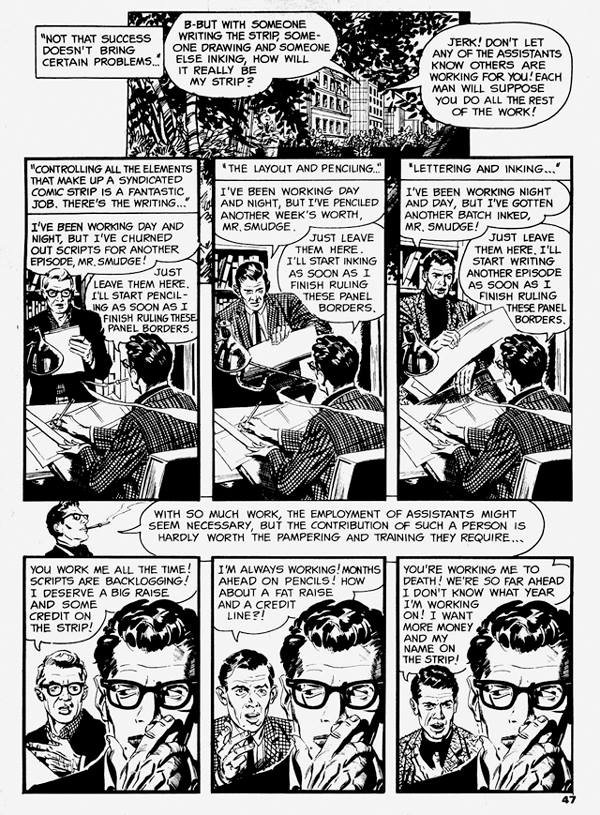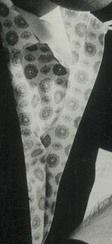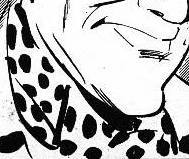home
Stan Me (Joe Simon Lampoons Stan Lee)


Patrick Ford
7 June 2016
The Nov. 1966 issue of SICK! magazine featured the story "The New Age of Comics" by Joe Simon and Angelo Torres. The three page story features a character named Stan Me who was obviously designed to lampoon Stan Lee. As a matter of fact Joe Simon wrote in his book THE COMIC BOOK MAKERS (which reprints the complete three page story) that he showed the story to Lee before he published. Simon says Lee's response was, "Very funny." The year 1966 is the immediate aftermath of both Steve Ditko and Wally Wood no longer selling their freelance stories to Lee in late 1965 and an article by Nat Freedland where Lee publicly ridiculed Steve Ditko which was published in the NEW YORK HERALD TRIBUNE in January of 1966.
The gist of the story makes it apparent that Lee was widely viewed within the industry as a pretentious fraud at that time.
A couple of interesting side notes. The story follows a story a story by Archie Goodwin and Al Williamson which was published in CREEPY #1, 1964. The story concerns a character named Baldo who is very similar to the Stan Me character.

CREEPY editor Russ Jones informed Dave Rawlins that the Baldo character was based on Don Sherwood a cartoonist who hired out all the work used to produce the DAN FLAGG newspaper strip. The distinction between Sherwood and Lee is at least the people writing for Sherwood got paid.
Angelo Torres and Al Williamson were close and both had experience working for Simon and both knew Kirby. Williamson had even been assigned by Simon to ink several stories penciled (and likely written) by Kirby.
In an interview with Steve Riggenberg published by TCJ, Williamson spoke of Simon ridiculing both Torres and Kirby.
Dave Rawlins: Baldo Smudge was based on Don Sherwood, whose Dan Flagg strip was ghosted by Goodwin, McWilliams and Williamson. Oh, and Ben Oda. This was told to me by Russ Jones, editor of Creepy.
Patrick Ford: That's great Dave Rawlins. It's the first time I've heard that.
Actually Lee was much worse than Sherwood, or Bob Kane. At least their ghosts got paid.
Lee was employing nothing less than flat out extortion. If a freelancer wanted assignments they had to write without being paid for the writing. I doubt Lee was ever that blunt, but his gestures were eloquent.
Patrick Ford: Don Sherwood. Spot ON.

Dave Rawlins: Russ said he wanted McWilliams to pencil and Williamson to ink, their respective jobs on Dan Flagg. But Williamson ended up doing all the art. Glad he did.
Patrick Ford: You mean on the Baldo story right? "The Success Story."
Dave Rawlins: Yep. BTW, Sherwood tried to keep all of them in the dark, pretending that he was doing everything else on the strip. Comics illustration being such a specialized occupation where everyone knew each other he was quickly found out.
Patrick Ford: Still though, like I said, they all were paid. To me that is the big distinction with Lee. In the case of Lee, Lee was taking the whole writers page rate while people like Kirby, Wood, and Ditko got nothing. And there is strong circumstantial evidence that Lee developed the "layout" method as a means of getting even more pages of writing for which Lee alone was paid.
Further I don't see any way what Kirby, Wood, and Ditko sold to Lee could be called "plotting."
Consider this. When Lee is said to have plotted (assuming he did) it was "just a few words." Or at most a synopsis. And I'm giving Lee the benefit of the doubt here for a moment just to make my point.
Well what Kirby, Wood, and Ditko supplied was really far more a full script than a Lee style plot. They didn't sell Lee "a few words." They sold him a complete story.
And if anyone does not think what they sold Lee was a complete story then I would suggest those people have never seen THE GOLD RUSH.
Dave Rawlins: Agreed. I suspect Lee's plots consisted of suggestions like, let's bring back Doctor Doom, or why don't we have Ant-Man guest star in the next issue.
Patrick Ford: And in the case of Ditko often times Lee's suggestions were completely rejected. And in the case of Kirby and Wood it seems Lee suggested nothing at all. That is exactly what Wood and Kirby said, and I have no reason to doubt them based on the evidence. The only thing I would cede to Lee in the case of Kirby and Wood is Lee mandating crossovers. If people want to say that, "Let's have the Sub-Mariner fight Daredevil, or "Let's have the Thing fight the Hulk" is a plot then let them.
With Kirby and Wood I don't think Lee even bothered faking it. With Ditko I have the feeling he tried to fool Ditko into coming up with plots which Lee would then try and convince Ditko that Lee had come up with them.
Wood and Kirby likely came across to Lee as guys who saw him as an mental midget. After not too long I think Lee started to notice Ditko was thinking the same thing.
To me the idea of Lee suggesting a plot to Kirby is akin to Danny DeVito showing Michael Jordan how to slam dunk. I honestly don't think Lee would even have the balls to pretend he could plot for Kirby. The air of contempt in the room would have been too much for Lee.
Which explains why Lee was out to treat Kirby as poorly as Lee's power allowed him to get away with.
J David Spurlock: "Let's have the Thing fight the Hulk" is all in the line of editorial direction -- a plot requires more than that
Patrick Ford: It's always amazing to me the animosity which is directed at Bob Kane while Stan Lee gets a pass.
At least Bill Finger got paid for writing. And Sheldon Moldoff and all Kane's other ghosts got paid for what they drew and Kane signed.
With Lee you have a man who took the whole writers page rate for around 8000 pages written by Kirby.
Patrick Ford: From my point of view this tacit endorsement of Lee is a complete condemnation of the entire comic book industry from the fan all the way up to management and everything in between.
Patrick Ford: People tend to ignore the fact that Kirby resented being assigned to layouts. The pay was around 1/4 to 1/3 of the page rate for penciling and Kirby considered the writing of a full script with breakdowns to be around 3/4 of the job.
At the same time Lee squeezed more pages of writing out of Ditko and assigning other people (Colletta and George Roussos) to ink Ditko. It is known (Ditko has objected to this practice in his essays) that Ditko was not happy about the idea.
And Lee assigned Wally Wood to layouts after Wood objected to not being paid for writing.
There is a claim that Lee assigned Wood to layouts (the claim is sourced to Lee) because Lee wanted more pages from Wood.
That may be true. In that case it would be more pages written by Wood that Lee could be paid for. Or it may simply be that Lee punished Wood by assigning him to layouts. The second theory makes more sense, because there never were more pages from Wood to compensate for him being assigned to layouts in a supposed effort to save Wood time.
Dave Rawlins: Take note of the fact that one of the swipes he took at Ditko in the infamous Herald Tribune article concerned the fact that Ditko insisted on inking his work. The last Hulk story Ditko turned in was the month before Ditko got plotting credit in Doctor Strange and Spider-Man. Lee tapped Kirby to take over the strip, which soon became Kirby doing layouts for Esposito and Powell. Meanwhile he was doing layouts for Toth, then Roth on X-Men and Tuska, Ayers, ect on Captain America.
Patrick Ford: Exactly. The facts are evident. Lee was trying to squeeze more pages out of people who could write, because Lee was just not capable of writing. It was pure and simple extortion.
Patrick Ford: Compared to Stan Lee, Bob Kane is St. Francis of Assisi.
Patrick Ford: Interesting that Sam Me is wearing the exact same spotted ascot that Don Sherwood is wearing.


Dave Rawlins: If the ascot fits...
Dave Rawlins: Torres was close with Williamson, perhaps an inside joke.
Patrick Ford: Williamson and Torres both worked on THE FLY along with Kirby. That was in 1959 and Kirby had already been selling work to Lee since 1956.
Patrick Ford: People either forget, or don't know, that Kirby worked on The Fly (i.e. Spiderman) while he was also selling 60 to 80 pages a month to Lee.
Tim Bateman: Easily done. I have to plead guilty on this one myself. Oh, well, at least I can take comfort in knowing that Kirby was selling to just about every publisher short of Western/Dell circa 1960 (following the SChiff incident).
Patrick Ford: Tim, It's because the history of comics is so poorly written. It isn't that the information is not given, it's there. The trouble is that for whatever reason comics histories tend to be written in terms of publishers. So rather than writing about Kirby's career, what is written about is Kirby at MLJ, Kirby at Crestwood, Kirby at DC, Kirby at Harvey, Kirby at Marvel, and that creates the impression there is a chain of events going neatly from one publisher to the next with minimal overlap. In fact it was not that way at all.
Patrick Ford: The average fan tends to think The Fly came before Kirby started selling work to Lee. Actually it came after Kirby began selling work to Lee.
J David Spurlock: Williamson and Goodwin's "Success Story" (Creepy #1) has NOTHING to do with Stan or Joe. For the sake of accuracy, I suggest you delete it and its mention. The story was about an actual newspaper strip artist. Out of decency, Al never acknowledged which one in print (but he did tell me and a few other friends in private).
Patrick Ford: You're way late J David. I edited the post hours ago. Go take a look.
Patrick Ford: If you note I still draw a line to Lee. The thing is Lee is much worse than Bob Kane or Don Sherwood. Because Kane and Sherwood at least paid their ghosts.
Patrick Ford: "The Success Story" is not about Stan Lee or Joe Simon, but it does have something to do with them because the unnamed protagonist (in reality Don Sherwood) works well as emblematic of those people in comics who relied on ghosts to get by.
Where it misses Lee is the fact that the main character in "The Success Story" is paying his ghosts. That makes him a shinning ethical example when compared to Stan Lee who collected writing payment for around 8000 pages written by Jack Kirby.
Patrick Ford" I've seen interviews with Julius Schwartz where Schwartz says he plotted most of the stories for the writers and then usually had to rewrite the dialogue. And yet the writer working with Schwartz always was paid for the writing.
home





